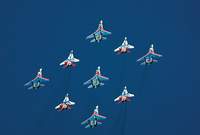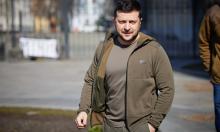Russia's largest air show MAKS-2007 opens with signing multi-million-dollar contracts
Russia's largest air show in post-Soviet history, MAKS-2007, opened yesterday, to display the growing military power of the nation and seek lucrative deals.

President Vladimir Putin, who recently ordered to resume the flights of long-range bombers to patrol the world's oceans, stressed Russia's prominence in production of military aircraft. Putin added that Russia must be competitive in building passenger airliners too.
The International Aviation and Space Show, held at a former secret military airfield outside Moscow, is an international trade fair showcasing Russia's latest military and civilian planes.
But reactions to the Russian hardware - both planes parked in hangers and others whizzing overhead - were mixed. While the commander of U.S. air forces in Europe expressed admiration for advanced Russian MiG and Sukhoi fighters, one military analyst characterized the same jets as "flying toys."
Putin, meanwhile, conceded nothing to critics of Russia's military aviation industry. "The task stands before us of maintaining our leadership in the production of military aviation technology," he said Tuesday at the start of the six-day show at Zhukovsky military airfield.
Russian manufacturers "must more actively enter the world market for passenger and transport aircraft with competitive production," he said.
After the 1991 Soviet collapse, the Russian government drastically cut spending on its aircraft manufacturing industry. Though factories producing military planes fared better than those building civilian aircraft - in part because they benefited from arms sales abroad - Russia fell behind the West in designing advanced warplanes.
Today, Russian passenger planes are so outdated that airlines flying to European and U.S. destinations must use Western-made planes to meet noise and pollution restrictions.
But the Kremlin is determined to revive the heyday of Soviet aviation, and the government - bolstered by oil and gas revenues - has invested in a new S-400 missile defense system and enhanced its MiG and Sukhoi fighter jets - all on exhibition at the show.
"The Russian air forces have some of the nicest aircraft I have ever seen," said Gen. William T. Hobbins, commander of U.S. air forces in Europe. "With a Sukhoi and MiG today, we have seen lots of new technology."
Others were less impressed.
"There's been nothing new there for 10 years," military analyst Pavel Felgenhauer said. He characterized the new MiG and Sukhoi fighter jets as "flying toys that have not been launched for mass production."
Nearly 800 companies from about 100 countries participated in the biannual show, state arms trader Rosoboronexport said, up from 70 at the last show. The largest foreign delegations were from China, Latin America and Arab countries.
The show follows recent moves to reassert Russia's military strength, including last week's joint military exercises with China - the first ever on Russian soil - and Putin's announcement that long-range bombers had resumed patrols over the Atlantic, Pacific and Arctic oceans.
The resumption of these patrols, which had been discontinued after the fall of the USSR, comes amid a growing chill in U.S.-Russian relations. Moscow has bristled over Washington's criticism of Russia's democracy record, objected to U.S. missile defense plans and opposed the war in Iraq.
Felgenhauer called the patrols "a return to the Cold War" and said the "poor state of Russian bombers" presented a risk of a serious accident.
Although there was concern about Russia's increasingly aggressive posture, one U.S. State Department official scoffed at the decision.
"If Russia feels as though they want to take some of these old aircraft out of mothballs and get them flying again, that's their decision," spokesman Sean McCormack said.
Russian officials said last Wednesday they planned to spend about US$250 billion (EUR 187 billion) to build about 4,500 civilian aircraft by 2025 as part of a program to revive the industry.
The investment comes at a crucial time for the civilian airline industry. Russia's passenger airlines own about 2,500 aircraft - just 100 of them Western-made models. But those 100 planes, accounting for just 4 percent of the fleet, carry nearly one-third of all passengers.
On Tuesday, the industry received more good news: Indonesia signed a contract with Russia for six Su-30 fighter jets worth a total of about US$350 million (EUR 260 million), the news agency Interfax reported.
U.S. giant Boeing Co. and Russia's JSC VSMPO-Avisma signed an agreement to create a joint venture to make titanium forgings for use in production of Boeing's 787 Dreamliner, Russian news agencies reported.
Specialists with Russia's space agency and the European Space Agency are slated for talks next month on creating a piloted spacecraft for missions to the international space station, as well as possibly the moon and Mars, reports said.
Alyona Gorobova, 24, a nurse with an ambulance at the show, watched with pride as jets screamed overhead.
"I don't doubt that our planes are the best," she said. "We just have to show it to the rest of the world."
Subscribe to Pravda.Ru Telegram channel, Facebook, RSS!





